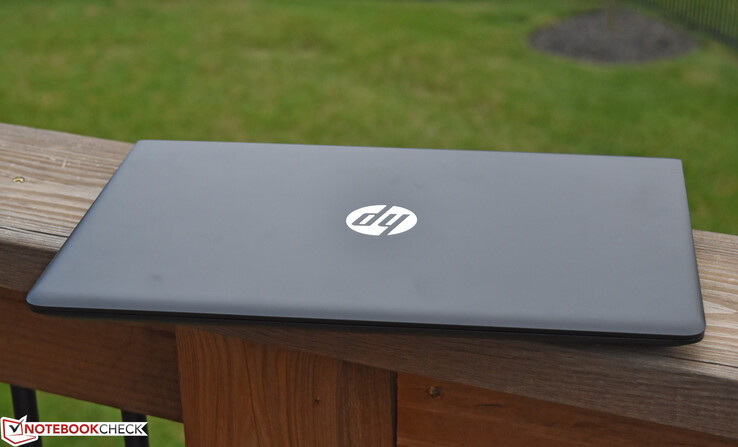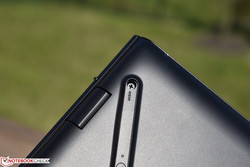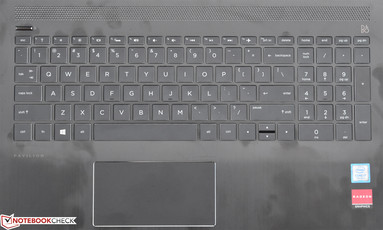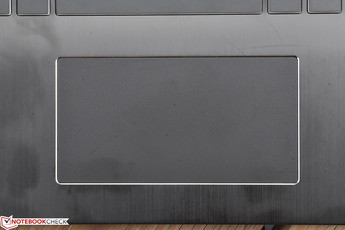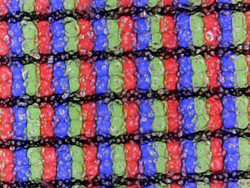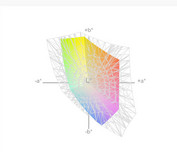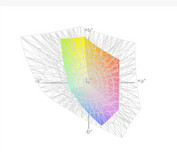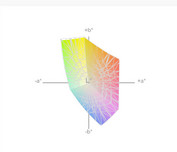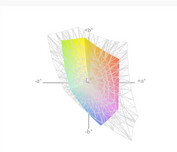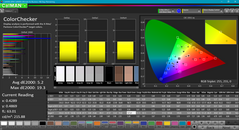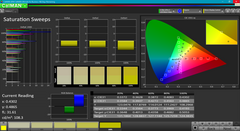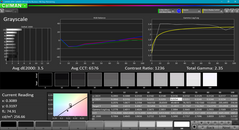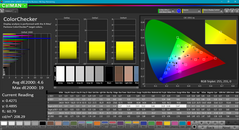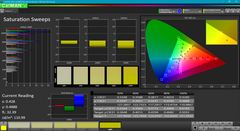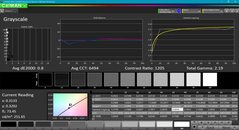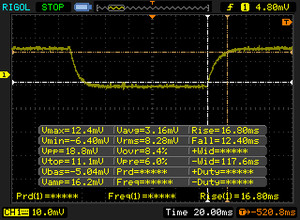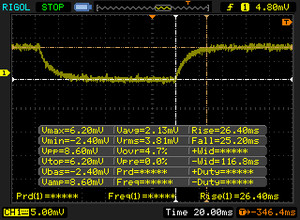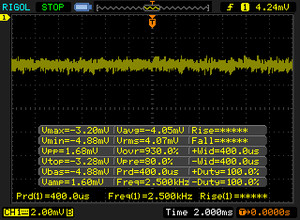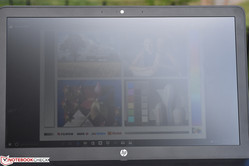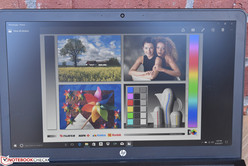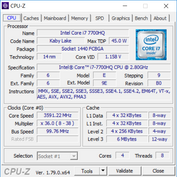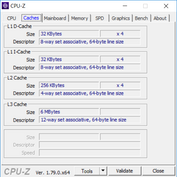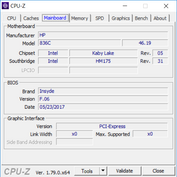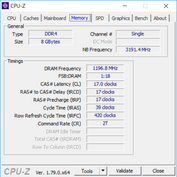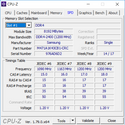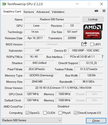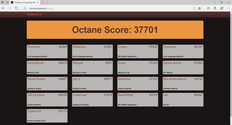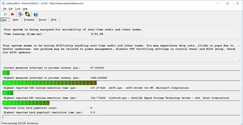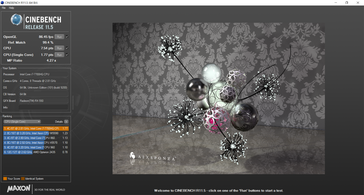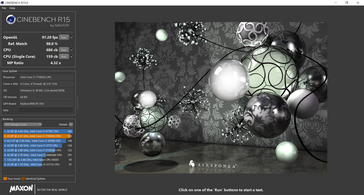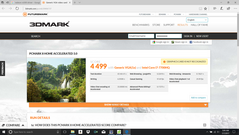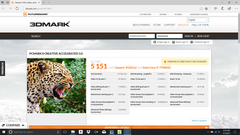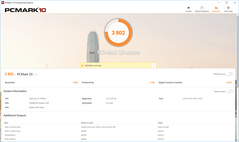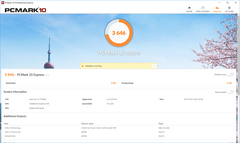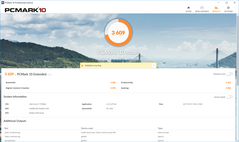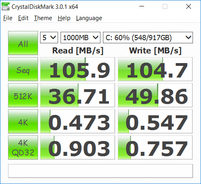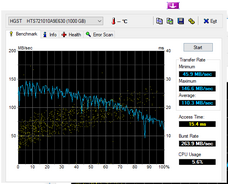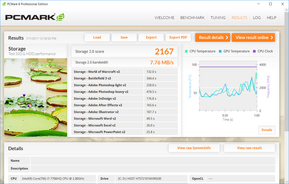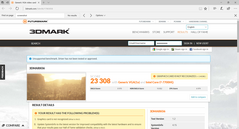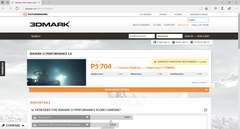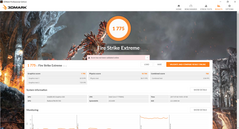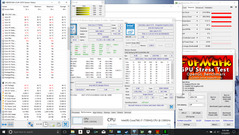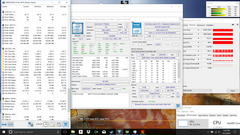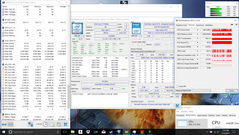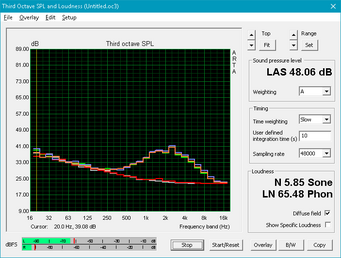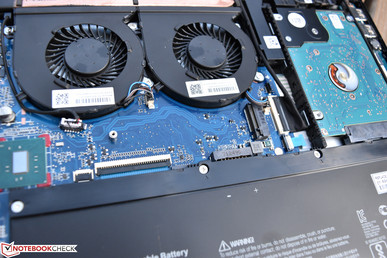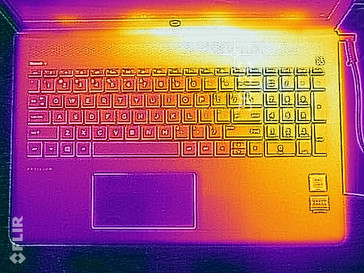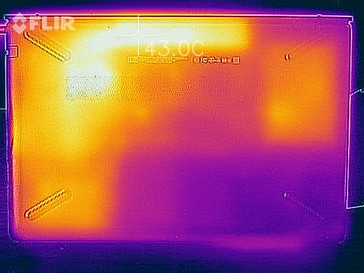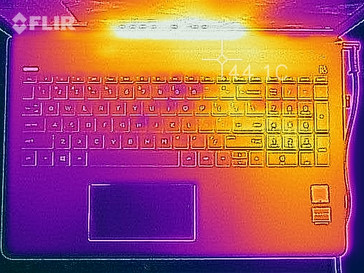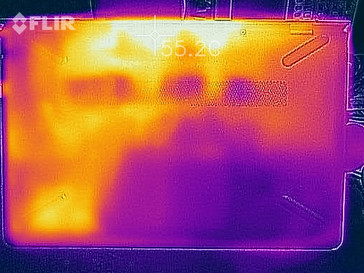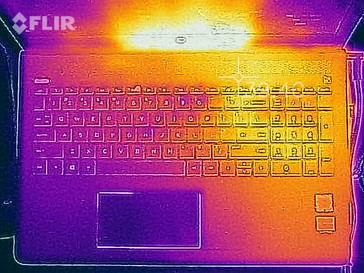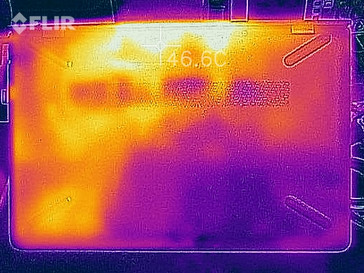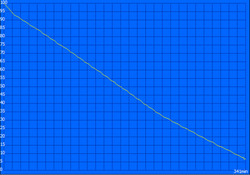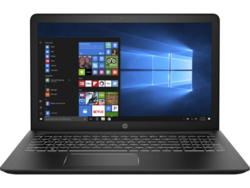HP Pavilion Power 15t-cb2000 (i7-7700HQ, Radeon RX 550) Laptop Review
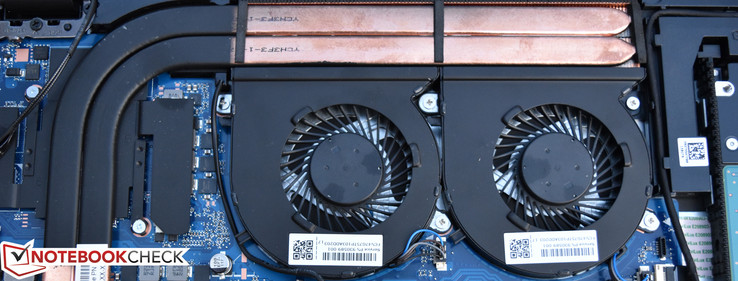
There’s a new top dog in HP’s Pavilion series, and it bears the appropriate title of Pavilion Power. These machines pack Intel Core i5 and i7 CPUs paired with dedicated graphics adapters. The first Pavilion Power we reviewed just several days ago featured an NVIDIA GTX 1050 and a dual-storage configuration (SSD + HDD) alongside a price tag of around $1,000. Today’s setup is a bit less expensive at roughly $880, but users will have to sacrifice in the way of both GPU and storage. The machine is primarily intended for users who are not interested in dropping another several hundred dollars for a competing notebook with higher-end components, such as one of the HP Omen series or a Lenovo Yoga 720.
Rather than a primary SSD, our review unit here includes only a mechanical 1 TB drive—and in place of the NVIDIA GPU, we now have an AMD Radeon RX 550 (still a relative newcomer with nothing yet to show in the Notebookcheck database). Elsewhere, 8 GB of RAM and a decent 1080p display round out what is a fairly pedestrian spec sheet—though still above what one might normally expect to see from a Pavilion. Is it worth saving a few bucks and springing for today’s $880 configuration instead? Let’s dig into the details and find out.
Case
The Pavilion Power 15t’s primarily plastic case actually seems somewhat sturdy for a notebook of its class, and it’s absolutely a step above that of the original Pavilion 15. The display lid carries a nondescript matte black finish which might more closely resemble something of a business machine were it not for the oversized metallic HP logo in the center. Speaking of the lid, it’s easily the weakest part of the package, as it’s fairly susceptible to twisting. On the other hand, the top of the base unit is lined with a rather stylish sheet of brushed aluminum, which looks great—that is, until it’s been touched, at which point it collects an unthinkable amount of fingerprints and skin oils. At least it provides a more robust feel than the display lid, yielding very little to pressure and carrying a more luxurious aesthetic than your everyday Pavilion.
The hinge is designed to drop down behind the rear of the base unit when opened, which in turn also props up the notebook during use (always a nice touch). This, of course, quashes any hope of rear-mounted ports or exhaust vents, but it’s hardly an unpopular approach. The hinges allow a bit more bounce than would be ideal during use (not uncommon for larger screens), but fortunately, the anti-glare display finish mitigates this problem.
Connectivity
The Pavilion Power 15t provides plenty of ports (all located on the sides thanks to the rear drop-hinge design), including a USB Type-C Gen 1 (up to 5 Gbps) port, bringing the total number of USB 3.0 ports to four. The only conspicuous omission is that of Thunderbolt 3.
SD Card Reader
Transfer rates for the integrated card reader are acceptable, though significantly slower than the category leaders. Based on our testing of the SSD-equipped Pavilion Power (as well as the much higher read speeds on this unit), however, upgrading the mechanical storage to an SSD would at least partially resolve this.
| SD Card Reader | |
| average JPG Copy Test (av. of 3 runs) | |
| HP Pavilion 15 Power 1GK62AV | |
| HP Omen 17-w206ng | |
| HP Omen 15-ax213ng | |
| Samsung Notebook 9 NP900X5N-X01US | |
| HP Pavilion Power 15t-cb2000 | |
| maximum AS SSD Seq Read Test (1GB) | |
| HP Pavilion Power 15t-cb2000 | |
| HP Omen 15-ax213ng | |
| HP Omen 17-w206ng | |
| Samsung Notebook 9 NP900X5N-X01US | |
| HP Pavilion 15 Power 1GK62AV | |
Communication
The Pavilion Power 15t managed wireless connectivity just fine in our testing in spite of incidentally being the slowest in the testing field by a small margin. We experienced no issues throughout our time with the machine, however.
Accessories
The 150 W AC Adapter (which uses the newer HP Ultrabook-style tip) is the only accessory included with the Pavilion Power laptop. The adapter isn’t terribly heavy (it weighs 430 grams).
Maintenance
Seven screws stand between the user and the machine’s internals, though two of the screws are stealthily situated beneath the top rubber feet—a potential pitfall for the would-be DIYer if they aren’t careful during disassembly. The case materials are also somewhat flimsy on the bottom and are attached with tricky plastic clips that could prove problematic for inexperienced users. Once inside, the battery, mechanical hard drive, WLAN adapter, both RAM sticks, and the heatsink/fan are easily replaced, however. There’s also room for an M.2 SSD (PCIe/NVMe supported) should the user choose to spring for an aftermarket dual-storage configuration—a choice which would greatly improve the speed of the system (more on this later).
Warranty
HP includes a standard one-year depot warranty on the Pavilion Power 15.
Input Devices
Keyboard
The Pavilion Power 15t’s keyboard can’t quite compete with category leaders (such as HP Spectre 15, Dell XPS 15, or ThinkPad models), but it’s still a good keyboard overall. Keypresses are quiet, and although they feature only a medium travel distance and softer feedback, they’re comfortable to use. There is little to no flex present during typing. The keys are backlit with only a single brightness setting (On or Off).
Touchpad
The Synaptics clickpad does a fine job with pointer responsiveness and gesture recognition, and there are plenty of options to boot (as usual). It’s a decently-sized pad which probably could have been a bit larger (again, see category leaders), but it’s fine. The only issue, as is often the case, are the integrated buttons, which feature plenty of travel but a softer bit of feedback. Separate physical buttons or a sharper response would have improved the feel.
Display
The Pavilion Power 15t includes the option for a 4K UHD IPS glossy touchscreen as well as a 4K UHD anti-glare IPS screen, but our review unit instead features an FHD (1920x1080) anti-glare display. It’s a 15.6-inch screen size, which factors out to a PPI of 141. The higher-end Omen series which HP has recently introduced also offers additional optional perks, such as panels with 120 Hz refresh rates and G-Sync. For the basics, however, the Pavilion Power’s screen appears to be more than adequate—and considering that the dedicated graphics adapter (the AMD Radeon RX 550) isn’t all that powerful, jumping up to a higher resolution would provide little (if any) benefit during gaming.
Subjectively speaking, the panel appears bright with good contrast. The matte finish yields a bit of graininess (typical of AUO anti-glare panels), but this is a matter of preference. We didn’t notice any mentionable backlight bleed during our testing.
| |||||||||||||||||||||||||
Brightness Distribution: 88 %
Center on Battery: 256 cd/m²
Contrast: 1219:1 (Black: 0.21 cd/m²)
ΔE ColorChecker Calman: 5.2 | ∀{0.5-29.43 Ø4.78}
ΔE Greyscale Calman: 3.5 | ∀{0.09-98 Ø5}
59% sRGB (Argyll 1.6.3 3D)
37% AdobeRGB 1998 (Argyll 1.6.3 3D)
40.59% AdobeRGB 1998 (Argyll 3D)
58.9% sRGB (Argyll 3D)
39.28% Display P3 (Argyll 3D)
Gamma: 2.35
CCT: 6576 K
| HP Pavilion Power 15t-cb2000 AUO41ED , IPS, 15.6", 1920x1080 | HP Pavilion 15 Power 1GK62AV ID: AU Optronics AUO41ED, IPS, 15.6", 1920x1080 | HP Omen 15-ax213ng AU Optronics AUO41ED, IPS, 15.6", 1920x1080 | HP Omen 17-w206ng Chi Mei CMN1738, IPS, 17.3", 1920x1080 | Samsung Notebook 9 NP900X5N-X01US ID: BOE06E8, Name: BOE HF NV150FHB-N31, IPS, 15", 1920x1080 | |
|---|---|---|---|---|---|
| Display | -1% | -2% | 65% | 66% | |
| Display P3 Coverage (%) | 39.28 | 38.81 -1% | 38.59 -2% | 67.2 71% | 65.2 66% |
| sRGB Coverage (%) | 58.9 | 57.9 -2% | 58 -2% | 93.1 58% | 97.7 66% |
| AdobeRGB 1998 Coverage (%) | 40.59 | 40.03 -1% | 39.87 -2% | 67.4 66% | 67.2 66% |
| Response Times | 15% | 12% | 19% | 5% | |
| Response Time Grey 50% / Grey 80% * (ms) | 51.6 ? | 38.8 ? 25% | 42 ? 19% | 38 ? 26% | 40.8 ? 21% |
| Response Time Black / White * (ms) | 29.2 ? | 28 ? 4% | 28 ? 4% | 26 ? 11% | 32.4 ? -11% |
| PWM Frequency (Hz) | 200 ? | 208.3 ? | |||
| Screen | 3% | 7% | 17% | 40% | |
| Brightness middle (cd/m²) | 256 | 256.6 0% | 230 -10% | 318 24% | 565.6 121% |
| Brightness (cd/m²) | 241 | 243 1% | 228 -5% | 295 22% | 524 117% |
| Brightness Distribution (%) | 88 | 81 -8% | 88 0% | 79 -10% | 88 0% |
| Black Level * (cd/m²) | 0.21 | 0.19 10% | 0.21 -0% | 0.25 -19% | 0.49 -133% |
| Contrast (:1) | 1219 | 1351 11% | 1095 -10% | 1272 4% | 1154 -5% |
| Colorchecker dE 2000 * | 5.2 | 5 4% | 4.01 23% | 4.7 10% | 2 62% |
| Colorchecker dE 2000 max. * | 19.3 | 20.1 -4% | 7.26 62% | 8.8 54% | 5 74% |
| Greyscale dE 2000 * | 3.5 | 2.7 23% | 3.18 9% | 5 -43% | 2.5 29% |
| Gamma | 2.35 94% | 2.32 95% | 2.52 87% | 2.28 96% | 2.21 100% |
| CCT | 6576 99% | 6599 98% | 6814 95% | 7374 88% | 6896 94% |
| Color Space (Percent of AdobeRGB 1998) (%) | 37 | 36.7 -1% | 37 0% | 61 65% | 61.2 65% |
| Color Space (Percent of sRGB) (%) | 59 | 57.7 -2% | 58 -2% | 93 58% | 97.5 65% |
| Total Average (Program / Settings) | 6% /
4% | 6% /
6% | 34% /
26% | 37% /
40% |
* ... smaller is better
Our measurements reveal a merely average brightness of 241 cd/m² alongside a very good contrast ratio of 1219:1, thanks to a low black value of 0.21 cd/m². The brightness distribution of 88% indicates a fairly uniform panel luminosity across all quadrants.
Covering only 59% of the sRGB spectrum (AdobeRGB: 37%), the display in the Pavilion Power is hardly suited to any sort of serious photo editing or graphical work.
CalMAN measurements show ColorChecker and Greyscale DeltaE2000 values of 5.2 and 3.5 respectively, which aren’t bad numbers for a basic 1080p panel. The CCT average of 6576 is also just about spot-on, and total gamma of 2.35 is also excellent. Blue hues are the only major problem, but ultimately the panel does an adequate job.
Display Response Times
| ↔ Response Time Black to White | ||
|---|---|---|
| 29.2 ms ... rise ↗ and fall ↘ combined | ↗ 16.8 ms rise | |
| ↘ 12.4 ms fall | ||
| The screen shows relatively slow response rates in our tests and may be too slow for gamers. In comparison, all tested devices range from 0.1 (minimum) to 240 (maximum) ms. » 77 % of all devices are better. This means that the measured response time is worse than the average of all tested devices (20.2 ms). | ||
| ↔ Response Time 50% Grey to 80% Grey | ||
| 51.6 ms ... rise ↗ and fall ↘ combined | ↗ 26.4 ms rise | |
| ↘ 25.2 ms fall | ||
| The screen shows slow response rates in our tests and will be unsatisfactory for gamers. In comparison, all tested devices range from 0.165 (minimum) to 636 (maximum) ms. » 88 % of all devices are better. This means that the measured response time is worse than the average of all tested devices (31.6 ms). | ||
Screen Flickering / PWM (Pulse-Width Modulation)
| Screen flickering / PWM not detected | |||
In comparison: 53 % of all tested devices do not use PWM to dim the display. If PWM was detected, an average of 8108 (minimum: 5 - maximum: 343500) Hz was measured. | |||
We detected no PWM from the display.
Outdoors, the panel is easily visible in the shade. Sunlight somewhat overpowers the mediocre brightness, but the matte finish and high contrast help. Still, the machine is not comfortable for use in direct sunlight. Viewing angles are excellent.
Performance
The Pavilion Power 15t can be equipped with either the Core i5-7300HQ or the Core i7-7700HQ. Two GPUs are also available: an AMD Radeon RX 550 (with 2 GB GDDR5 VRAM) or an NVIDIA GeForce GTX 1050 (with 4 GB GDDR5). RAM, meanwhile, ranges from 6 GB DDR4-2400 up to 16 GB (2 x 8 GB dual-channel). Fortunately, RAM is possible (if slightly inconvenient) to upgrade aftermarket if you choose to go low from the start (see our maintenance section earlier in this review).
LatencyMon did report some spikes, but based on our subjective analysis they seemed to be somewhat infrequent. Performance while unplugged, meanwhile, is unsurprisingly lower, with a total score of 1477 in 3DMark 11 achieved while operating on battery power.
Processor
As mentioned above, just two processors are available for configuration in the Pavilion Power 15t: the Intel Core i5-7300HQ and Core i7-7700HQ. Both are quite powerful mobile CPUs (with 45 W TDP) and have been extensively evaluated here at Notebookcheck over the months. Our review unit features the Core i7-7700HQ, which is a quad-core CPU with a base clock rate of 2.8 GHz and a boost frequency of 3.8 GHz.
Performance on our review unit was disappointing for a Core i7-7700HQ-equipped notebook. Over longer-term periods, the Pavilion Power 15t seems to lag behind its peers, especially in multi-core tests, where we saw an 8% discrepancy between the GTX 1050-equipped Pavilion Power and today’s AMD Radeon-outfitted one. Even stranger was the wPrime performance, where the GTX-equipped Pavilion managed 212 seconds, but our review unit today (equipped with the same CPU took 332 to complete the same task—57% longer. We’ll discover later that this was actually the product of near-immediate throttling on the part of the CPU just seconds after the benchmarks began.
One might expect the Cinebench R15 loop test to further illuminate these deficiencies, but in fact, since the throttling sets in so rapidly, there isn’t a huge drop in performance when moving from the first value to later ones. Instead, all of them are pretty mediocre, with the best overall score we received being a 686 (for reference, the GTX-equipped Pavilion 15 Power managed a 740).
| wPrime 2.10 - 1024m | |
| Samsung Notebook 9 NP900X5N-X01US | |
| HP Pavilion Power 15t-cb2000 | |
| HP Pavilion 15 Power 1GK62AV | |
* ... smaller is better
System Performance
PCMark 8 synthetic performance scores, on the other hand, are positive across the board—which is actually rather surprising considering the lack of a solid-state drive in the Pavilion Power configuration we are reviewing today. Scores like 4627 in PCMark 8 Work Accelerated v2 and 4499 in Home Accelerated v2 suggest a very capable machine—but we subjectively noticed some stuttering and sluggishness when loading applications and games thanks to the lack of faster storage.
| PCMark 8 | |
| Home Score Accelerated v2 | |
| HP Pavilion Power 15t-cb2000 | |
| HP Omen 17-w206ng | |
| HP Omen 15-ax213ng | |
| HP Pavilion 15 Power 1GK62AV | |
| Samsung Notebook 9 NP900X5N-X01US | |
| Work Score Accelerated v2 | |
| HP Pavilion 15 Power 1GK62AV | |
| Samsung Notebook 9 NP900X5N-X01US | |
| HP Pavilion Power 15t-cb2000 | |
| HP Omen 15-ax213ng | |
| Creative Score Accelerated v2 | |
| HP Omen 15-ax213ng | |
| HP Pavilion 15 Power 1GK62AV | |
| HP Pavilion Power 15t-cb2000 | |
| Samsung Notebook 9 NP900X5N-X01US | |
| PCMark 8 Home Score Accelerated v2 | 4499 points | |
| PCMark 8 Creative Score Accelerated v2 | 5151 points | |
| PCMark 8 Work Score Accelerated v2 | 4627 points | |
| PCMark 10 Score | 3802 points | |
Help | ||
Storage Devices
Our previous Pavilion Power 15 configuration was powered by an SK Hynix solid-state drive, and although performance was overall merely acceptable, it’s still lightyears ahead of what we’re seeing today in our hard drive-equipped iteration. Our machine bucks the trend of the rest of the field with a comparably inexpensive (and large) HGST Travelstar 7K1000 1 TB mechanical hard drive—which, to its credit, is among the faster drives around… but it obviously can’t compete with an SSD. The charts below illustrate this, with sequential read/write speeds—and especially 4K/512K speeds—worlds apart between the two approaches. Fortunately, aftermarket upgrades are pretty straightforward on the Pavilion Power, so if you’re stuck with the mechanical blues, it’s not hard to make the jump to pure silicon (dual storage is possible with the addition of an M.2 SSD).
| HP Pavilion Power 15t-cb2000 HGST Travelstar 7K1000 HTS721010A9E630 | HP Pavilion 15 Power 1GK62AV SK Hynix HFS256G39TND-N210A | HP Omen 15-ax213ng Samsung PM961 MZVLW256HEHP | HP Omen 17-w206ng Samsung PM961 MZVLW256HEHP | Samsung Notebook 9 NP900X5N-X01US Samsung PM961 MZVLW256HEHP | |
|---|---|---|---|---|---|
| CrystalDiskMark 3.0 | 8924% | 24609% | 22337% | 19660% | |
| Read Seq (MB/s) | 105.9 | 491.6 364% | 1657 1465% | 1606 1417% | 1447 1266% |
| Write Seq (MB/s) | 104.7 | 141.7 35% | 1208 1054% | 1176 1023% | 1281 1123% |
| Read 512 (MB/s) | 36.71 | 345.6 841% | 806 2096% | 846 2205% | 651 1673% |
| Write 512 (MB/s) | 49.86 | 142.6 186% | 807 1519% | 805 1515% | 765 1434% |
| Read 4k (MB/s) | 0.473 | 18.83 3881% | 62.6 13135% | 59.9 12564% | 58.3 12226% |
| Write 4k (MB/s) | 0.547 | 76.3 13849% | 176.9 32240% | 155.6 28346% | 131.9 24013% |
| Read 4k QD32 (MB/s) | 0.903 | 348.5 38494% | 650 71882% | 588 65016% | 545 60254% |
| Write 4k QD32 (MB/s) | 0.757 | 104.8 13744% | 557 73480% | 505 66611% | 419.3 55290% |
GPU Performance
The big question remaining today is the performance of the AMD Radeon RX 550, a newcomer in the mobile GPU space which has yet to be tested here at Notebookcheck. Today, we have our first look at the performance of this GPU, which is a Polaris 12-based adapter that’s manufactured using a 14 nm FinFET process. It packs 640 shaders, though only 512 are activated in the RX 550.
So, how does it fare? In short, it’s not terribly impressive, though it should be capable of handling most modern games at low- to mid-range settings regardless. The RX 550 posts scores in our benchmarks near the Radeon Pro 455 (found in the 2016 MacBook Pro) and pretty consistently some 15 – 40% below the average scores of the NVIDIA GTX 1050. That squarely places the RX 550 in the mid-range category, which isn’t a bad place to be given its somewhat affordable pricing.
Still, we should mention some driver-related woes we experienced during testing which required us to update and reinstall the device before a number of benchmarks would successfully complete. We did eventually revert back to the most recent RX 550 WHQL-certified driver, but during PCMark and some 3DMark tests, we found better stability—and comparable performance—with generic Radeon 500 Series GPU drivers. This was with the latest program versions and SystemInfo installation, of course, so we’re not sure precisely what the problem was here.
| 3DMark 06 Standard Score | 23308 points | |
| 3DMark 11 Performance | 5704 points | |
| 3DMark Ice Storm Standard Score | 92226 points | |
| 3DMark Cloud Gate Standard Score | 15004 points | |
| 3DMark Fire Strike Score | 3738 points | |
| 3DMark Fire Strike Extreme Score | 1775 points | |
| 3DMark Time Spy Score | 1302 points | |
Help | ||
Gaming Performance
The RX 550—and, more generally, Pavilion Power 15t equipped with it—can easily handle games that are a few years old at native resolution on high settings. However, newer games—such as Rise of the Tomb Raider, DOOM, and Ashes of the Singularity—can only be enjoyed at mid-range settings. It won’t be long, then, before the RX 550 is relegated to the sidelines, unable to manage newer games on all but lower resolutions. For that reason, it’d be hard to recommend springing for the UHD display in the Pavilion Power 15 (even with the GTX 1050 inside). There just aren’t any practical gaming scenarios involving it with these two GPUs.
| Metro: Last Light | |
| 1920x1080 Very High (DX11) AF:16x (sort by value) | |
| HP Pavilion Power 15t-cb2000 | |
| HP Pavilion 15 Power 1GK62AV | |
| 1366x768 High (DX11) AF:16x (sort by value) | |
| HP Pavilion Power 15t-cb2000 | |
| HP Pavilion 15 Power 1GK62AV | |
| HP 15-bw077ax | |
| 1366x768 Medium (DX10) AF:4x (sort by value) | |
| HP Pavilion Power 15t-cb2000 | |
| HP 15-bw077ax | |
| 1024x768 Low (DX10) AF:4x (sort by value) | |
| HP Pavilion Power 15t-cb2000 | |
| HP 15-bw077ax | |
| Thief | |
| 1920x1080 Very High Preset AA:FXAA & High SS AF:8x (sort by value) | |
| HP Pavilion Power 15t-cb2000 | |
| HP Pavilion 15 Power 1GK62AV | |
| 1366x768 High Preset AA:FXAA & Low SS AF:4x (sort by value) | |
| HP Pavilion Power 15t-cb2000 | |
| HP Pavilion 15 Power 1GK62AV | |
| 1366x768 Normal Preset AA:FX (sort by value) | |
| HP Pavilion Power 15t-cb2000 | |
| 1024x768 Very Low Preset (sort by value) | |
| HP Pavilion Power 15t-cb2000 | |
| The Witcher 3 | |
| 1920x1080 Ultra Graphics & Postprocessing (HBAO+) (sort by value) | |
| HP Pavilion Power 15t-cb2000 | |
| HP Pavilion 15 Power 1GK62AV | |
| HP Omen 15-ax213ng | |
| HP Omen 17-w206ng | |
| 1920x1080 High Graphics & Postprocessing (Nvidia HairWorks Off) (sort by value) | |
| HP Pavilion 15 Power 1GK62AV | |
| HP Omen 15-ax213ng | |
| HP Omen 17-w206ng | |
| 1366x768 Medium Graphics & Postprocessing (sort by value) | |
| HP Pavilion 15 Power 1GK62AV | |
| HP Omen 15-ax213ng | |
| HP Omen 17-w206ng | |
| 1024x768 Low Graphics & Postprocessing (sort by value) | |
| HP Omen 15-ax213ng | |
| HP Omen 17-w206ng | |
| Samsung Notebook 9 NP900X5N-X01US | |
| HP 15-bw077ax | |
| HP Pavilion 17z 1EX13AV | |
| Rise of the Tomb Raider | |
| 1920x1080 Very High Preset AA:FX AF:16x (sort by value) | |
| HP Pavilion Power 15t-cb2000 | |
| HP Pavilion 15 Power 1GK62AV | |
| HP Omen 15-ax213ng | |
| 1920x1080 High Preset AA:FX AF:4x (sort by value) | |
| HP Pavilion Power 15t-cb2000 | |
| HP Pavilion 15 Power 1GK62AV | |
| HP Omen 15-ax213ng | |
| Samsung Notebook 9 NP900X5N-X01US | |
| 1366x768 Medium Preset AF:2x (sort by value) | |
| HP Pavilion Power 15t-cb2000 | |
| HP Omen 15-ax213ng | |
| Samsung Notebook 9 NP900X5N-X01US | |
| HP 15-bw077ax | |
| HP Pavilion 17z 1EX13AV | |
| 1024x768 Lowest Preset (sort by value) | |
| HP Pavilion Power 15t-cb2000 | |
| HP Omen 15-ax213ng | |
| Samsung Notebook 9 NP900X5N-X01US | |
| HP 15-bw077ax | |
| HP Pavilion 17z 1EX13AV | |
| Asus X555DA-BB11 | |
| Batman: Arkham Knight | |
| 1920x1080 High / On AA:SM AF:16x (sort by value) | |
| HP Pavilion Power 15t-cb2000 | |
| HP Pavilion 15 Power 1GK62AV | |
| 1920x1080 High / On (Interactive Smoke & Paper Debris Off) AA:SM AF:8x (sort by value) | |
| HP Pavilion Power 15t-cb2000 | |
| 1366x768 Normal / Off AF:4x (sort by value) | |
| HP Pavilion Power 15t-cb2000 | |
| HP Pavilion 15 Power 1GK62AV | |
| HP 15-bw077ax | |
| 1280x720 Low / Off AF:Trilinear (sort by value) | |
| HP Pavilion Power 15t-cb2000 | |
| HP Pavilion 15 Power 1GK62AV | |
| HP 15-bw077ax | |
| HP Pavilion 17z 1EX13AV | |
| Ashes of the Singularity | |
| 1280x768 low (sort by value) | |
| HP Pavilion Power 15t-cb2000 | |
| HP Pavilion 15 Power 1GK62AV | |
| HP 15-bw077ax | |
| 1920x1080 Standard (sort by value) | |
| HP Pavilion Power 15t-cb2000 | |
| HP Pavilion 15 Power 1GK62AV | |
| 1920x1080 high (sort by value) | |
| HP Pavilion Power 15t-cb2000 | |
| HP Pavilion 15 Power 1GK62AV | |
| Doom | |
| 1920x1080 Ultra Preset AA:SM (sort by value) | |
| HP Pavilion Power 15t-cb2000 | |
| HP Pavilion 15 Power 1GK62AV | |
| 1920x1080 High Preset AA:FX (sort by value) | |
| HP Pavilion Power 15t-cb2000 | |
| HP Pavilion 15 Power 1GK62AV | |
| 1366x768 Medium Preset (sort by value) | |
| HP Pavilion Power 15t-cb2000 | |
| HP Pavilion 15 Power 1GK62AV | |
| 1280x720 Low Preset (sort by value) | |
| HP Pavilion Power 15t-cb2000 | |
| HP Pavilion 15 Power 1GK62AV | |
| HP Pavilion 17z 1EX13AV | |
| low | med. | high | ultra | |
|---|---|---|---|---|
| Tomb Raider (2013) | 289.8 | 149.5 | 114.9 | 51.2 |
| BioShock Infinite (2013) | 183 | 133 | 117 | 67 |
| Metro: Last Light (2013) | 90 | 85.4 | 59.5 | 28.4 |
| Thief (2014) | 65.2 | 58.3 | 55.1 | 29 |
| The Witcher 3 (2015) | 24 | |||
| Batman: Arkham Knight (2015) | 82 | 71 | 39 | 27 |
| Rise of the Tomb Raider (2016) | 91 | 54 | 27 | 21 |
| Ashes of the Singularity (2016) | 41.9 | 25.4 | 22 | |
| Doom (2016) | 56 | 37 | 22 | 21 |
Stress Test
During our stress testing, the problems with the Pavilion Power 15 machine we received for review became immediately clear: the reasons for the reduced CPU performance were absolutely thermal in nature, and worst of all, thanks to their near-immediate onset, the reduced performance associated with them was not immediately evident based on our sustained performance tests and graphs. In other words, performance was never awful as a result of the thermal limitations, just below average in most cases (5 to 10 percent below the previous Pavilion Power generally).
We witnessed CPU temperatures of 84 °C on average and as high as 96 °C during our stress testing, which almost certainly indicates a problem with the cooling system on this particular unit. Clock rates were understandably affected, shuffling around within the 2.6 – 3.4 GHz range.
GPU stress was less of a problem for the machine, but it still could not sustain maximum boost frequencies or even base core frequencies permanently. We recorded average clock rates starting at around 1100 MHz (the base frequency for the chip), but soon after, as temperatures reached into the 70s, the clock rates dropped to between 1017 and 1070 MHz, with an average temperature of 72 °C.
Combined stress, of course, once again brought the system to its knees (primarily thanks to the CPU cooling woes, naturally): we saw 2.7 GHz / 900 MHz as estimated averages for both CPU and GPU, respectively, which aren’t bad numbers by themselves. However, take a quick look at the graph of the GPU clock rates in our attached screenshots and you’ll see that it was anything but consistent. Oddly enough, however, this did not appear to be a thermal limitation; GPU temperatures were no higher than before, and the CPU clock rate remained at a reasonable 2.7 GHz throughout – not far from where it was during separate CPU stress.
Our more realistic Witcher 3 benchmark showed no signs of real concern, with fairly stable frame rates of between 22 and 25 fps on average, and hardly any dips or spikes beyond that region.
| CPU Clock (GHz) | GPU Clock (MHz) | Average CPU Temperature (°C) | Average GPU Temperature (°C) | |
| Prime95 Stress | 2.6 - 3.4 | - | 84 | - |
| FurMark Stress | - | 1017 - 1070 | 56 | 72 |
| Prime95 + FurMark Stress | 2.7 | 350 - 1100 | 89 | 72 |
Emissions
System Noise
Although it’s relatively quiet while idling—with an average of 30.9 dB(A) and a max value of just 31.1 dB(A)—the Pavilion Power 15t is the noisiest machine in our comparison field under load, with consistently high-RPM fan speeds producing equally consistent readings of 50.2 dB(A) across the board. The fan remains at this speed under nearly all gaming or high-load situations, and it doesn’t take long to climb its way there, either (there seems to be hardly any middle ground, with the fan mostly going from relatively quiet directly to high-speed... but again, this could be a product of the CPU thermal issues we experienced). Bear in mind that many competing notebooks also feature faster and more power-hungry GPUs (namely, the GTX 1050 and 1050 Ti). We did not experience any electronic noise during our test period.
Noise level
| Idle |
| 30.8 / 30.9 / 31.1 dB(A) |
| Load |
| 50.2 / 50.2 dB(A) |
 | ||
30 dB silent 40 dB(A) audible 50 dB(A) loud |
||
min: | ||
| HP Pavilion Power 15t-cb2000 Radeon RX 550 (Laptop), i7-7700HQ, HGST Travelstar 7K1000 HTS721010A9E630 | HP Pavilion 15 Power 1GK62AV GeForce GTX 1050 Mobile, i7-7700HQ, SK Hynix HFS256G39TND-N210A | HP Omen 15-ax213ng GeForce GTX 1050 Ti Mobile, i7-7700HQ, Samsung PM961 MZVLW256HEHP | HP Omen 17-w206ng GeForce GTX 1050 Ti Mobile, i7-7700HQ, Samsung PM961 MZVLW256HEHP | Samsung Notebook 9 NP900X5N-X01US GeForce 940MX, i7-7500U, Samsung PM961 MZVLW256HEHP | |
|---|---|---|---|---|---|
| Noise | 2% | -5% | -6% | 12% | |
| off / environment * (dB) | 28.4 | 27.8 2% | 30 -6% | 30 -6% | 28.3 -0% |
| Idle Minimum * (dB) | 30.8 | 32.1 -4% | 32 -4% | 34 -10% | 28.3 8% |
| Idle Average * (dB) | 30.9 | 32.2 -4% | 34 -10% | 35 -13% | 28.3 8% |
| Idle Maximum * (dB) | 31.1 | 32.2 -4% | 36 -16% | 36 -16% | 28.3 9% |
| Load Average * (dB) | 50.2 | 43.3 14% | 48 4% | 47 6% | 38.3 24% |
| Witcher 3 ultra * (dB) | 50.2 | 45 10% | 49 2% | 48 4% | |
| Load Maximum * (dB) | 50.2 | 49.6 1% | 51 -2% | 52 -4% | 38.3 24% |
* ... smaller is better
Temperature
Surprisingly, today’s RX 550-equipped Pavilion Power 15t runs cooler overall than the GeForce 1050 version we reviewed a couple of weeks ago, though the same general observations still apply here. This is likely thanks to the fact that, thanks to what appears to be a flaw in the cooling system in our unit, what would normally have been higher temperatures in aggregate across the breadth of the case (spread out by a properly-functioning heatsink/fan) are exchanged instead for hotter internal CPU temperatures.
For starters, the bottom of the notebook can get quite warm, with a hot spot in the center top quadrant that reached 54 °C in our measurements. Likewise, the right side of the notebook (when upright) tends to become much warmer than the left due to the positioning of the CPU/GPU and corresponding heat pipes. This leads to a sweaty right palm during gaming sessions, though the left side of the keyboard remains comfortably cool (a difference of roughly 10 °C in fact between the two). Overall load averages of 35.5 °C and 38.1 °C aren’t bad, though.
(±) The maximum temperature on the upper side is 43.4 °C / 110 F, compared to the average of 36.9 °C / 98 F, ranging from 21.1 to 71 °C for the class Multimedia.
(-) The bottom heats up to a maximum of 54 °C / 129 F, compared to the average of 39.2 °C / 103 F
(+) In idle usage, the average temperature for the upper side is 31.5 °C / 89 F, compared to the device average of 31.3 °C / 88 F.
(±) Playing The Witcher 3, the average temperature for the upper side is 32.2 °C / 90 F, compared to the device average of 31.3 °C / 88 F.
(±) The palmrests and touchpad can get very hot to the touch with a maximum of 37.8 °C / 100 F.
(-) The average temperature of the palmrest area of similar devices was 28.7 °C / 83.7 F (-9.1 °C / -16.3 F).
Speakers
The Pavilion Power 15’s speakers produced some 74.62 dB of sound, which is an average volume level. There’s hardly any bass present, but mids and highs are both unoffensive. As pictured in the pink noise graph, the high and low frequencies are somewhat uneven. The speakers aren’t particularly bad, but they aren’t up to par with what we’d expect to see from a multimedia machine.
HP Pavilion Power 15t-cb2000 audio analysis
(±) | speaker loudness is average but good (74.6 dB)
Bass 100 - 315 Hz
(-) | nearly no bass - on average 16.2% lower than median
(±) | linearity of bass is average (13.8% delta to prev. frequency)
Mids 400 - 2000 Hz
(+) | balanced mids - only 4.3% away from median
(+) | mids are linear (6.8% delta to prev. frequency)
Highs 2 - 16 kHz
(+) | balanced highs - only 3.1% away from median
(±) | linearity of highs is average (8.3% delta to prev. frequency)
Overall 100 - 16.000 Hz
(±) | linearity of overall sound is average (25.4% difference to median)
Compared to same class
» 89% of all tested devices in this class were better, 3% similar, 8% worse
» The best had a delta of 5%, average was 17%, worst was 45%
Compared to all devices tested
» 77% of all tested devices were better, 5% similar, 18% worse
» The best had a delta of 4%, average was 24%, worst was 134%
Apple MacBook 12 (Early 2016) 1.1 GHz audio analysis
(+) | speakers can play relatively loud (83.6 dB)
Bass 100 - 315 Hz
(±) | reduced bass - on average 11.3% lower than median
(±) | linearity of bass is average (14.2% delta to prev. frequency)
Mids 400 - 2000 Hz
(+) | balanced mids - only 2.4% away from median
(+) | mids are linear (5.5% delta to prev. frequency)
Highs 2 - 16 kHz
(+) | balanced highs - only 2% away from median
(+) | highs are linear (4.5% delta to prev. frequency)
Overall 100 - 16.000 Hz
(+) | overall sound is linear (10.2% difference to median)
Compared to same class
» 7% of all tested devices in this class were better, 2% similar, 91% worse
» The best had a delta of 5%, average was 18%, worst was 53%
Compared to all devices tested
» 4% of all tested devices were better, 1% similar, 94% worse
» The best had a delta of 4%, average was 24%, worst was 134%
Energy Management
Power Consumption
Although power consumption numbers are appropriately low under load (with an average of 60.1 W and max/realistic values of around 80 W), the Pavilion Power 15t’s idle values are far higher than any of the rest of the NVIDIA-equipped field. We recorded an idle average of 19.6 W, which is double that of the Pavilion Power with the GeForce GTX 1050 (the idle minimum wasn’t even that much lower at 18.7 W). Needless to say, this suggests that battery life benchmarks should also be adversely affected—and that anyone who has a need for lower power (and correspondingly, heat) usage should avoid the RX 550 and pony up for the GTX 1050 instead.
One other note here: the maximum power draw under synthetic stress (Prime95 + FurMark) was only 80.6 W, which leaves nearly 70 W of overhead when the 150 W AC adapter is taken into account. This means that hypothetically HP could have provided a much smaller 90 W adapter and it still would have sufficed. Nevertheless, this isn’t really a problem, just a curiosity.
| Off / Standby | |
| Idle | |
| Load |
|
Key:
min: | |
| HP Pavilion Power 15t-cb2000 i7-7700HQ, Radeon RX 550 (Laptop), HGST Travelstar 7K1000 HTS721010A9E630, IPS, 1920x1080, 15.6" | HP Pavilion 15 Power 1GK62AV i7-7700HQ, GeForce GTX 1050 Mobile, SK Hynix HFS256G39TND-N210A, IPS, 1920x1080, 15.6" | HP Omen 15-ax213ng i7-7700HQ, GeForce GTX 1050 Ti Mobile, Samsung PM961 MZVLW256HEHP, IPS, 1920x1080, 15.6" | HP Omen 17-w206ng i7-7700HQ, GeForce GTX 1050 Ti Mobile, Samsung PM961 MZVLW256HEHP, IPS, 1920x1080, 17.3" | Samsung Notebook 9 NP900X5N-X01US i7-7500U, GeForce 940MX, Samsung PM961 MZVLW256HEHP, IPS, 1920x1080, 15" | |
|---|---|---|---|---|---|
| Power Consumption | 10% | 0% | -18% | 41% | |
| Idle Minimum * (Watt) | 18.7 | 9.4 50% | 6 68% | 11 41% | 5 73% |
| Idle Average * (Watt) | 19.6 | 9.7 51% | 11 44% | 18 8% | 11.6 41% |
| Idle Maximum * (Watt) | 21.7 | 16.8 23% | 18 17% | 24 -11% | 12.2 44% |
| Load Average * (Watt) | 60.1 | 76.5 -27% | 81 -35% | 84 -40% | 47.8 20% |
| Witcher 3 ultra * (Watt) | 80.5 | 86.5 -7% | 90 -12% | 101 -25% | 51.9 36% |
| Load Maximum * (Watt) | 80.6 | 105.6 -31% | 146 -81% | 146 -81% | 55.7 31% |
* ... smaller is better
Battery Life
Unsurprisingly, load values (obtained using the Battery Eater Pro Classic Test) are nearly identical between the GTX 1050 Pavilion Power 15 and the Radeon RX 550 version we’re reviewing today. However, as predicted based on our power consumption readings above, the true difference is seen during lower power states. Our web surfing script lasted 5 hours and 41 minutes on the AMD-equipped Pavilion, which isn’t a bad result by itself, but which is nevertheless nearly two-and-a-half hours shorter than the NVIDIA version achieved. This must be primarily a factor of the GPU, since the only other major component-level difference between the two machines is the storage drive. It’s also the shortest runtime in this test of any of the laptops we’re comparing against today.
| HP Pavilion Power 15t-cb2000 i7-7700HQ, Radeon RX 550 (Laptop), 70 Wh | HP Pavilion 15 Power 1GK62AV i7-7700HQ, GeForce GTX 1050 Mobile, 70 Wh | HP Omen 15-ax213ng i7-7700HQ, GeForce GTX 1050 Ti Mobile, 63.3 Wh | HP Omen 17-w206ng i7-7700HQ, GeForce GTX 1050 Ti Mobile, 62 Wh | Samsung Notebook 9 NP900X5N-X01US i7-7500U, GeForce 940MX, 66 Wh | |
|---|---|---|---|---|---|
| Battery runtime | 30% | 10% | 7% | 79% | |
| Reader / Idle (h) | 10.5 | 16.2 54% | 12.8 22% | 13.3 27% | 27.4 161% |
| WiFi v1.3 (h) | 5.7 | 8 40% | 7.1 25% | 6.3 11% | 10.1 77% |
| Load (h) | 1.9 | 1.8 -5% | 1.6 -16% | 1.6 -16% | 1.9 0% |
Pros
Cons
Verdict
At just $880, today’s Pavilion Power 15 configuration is certifiably midrange in just about every way. Apart from the popular Core i7-7700HQ, the machine includes 8 GB of RAM and affordable dedicated graphics, as well as a pretty decent FHD anti-glare display. It also sports a fairly sturdy build and a healthy selection of ports (though Thunderbolt 3 is missing). It works well enough under the circumstances as an entry-level gaming machine—provided the user isn't under the impression that games in the near future will remain as playable as today’s.
The Pavilion Power 15t with AMD RX 550 graphics works well enough as an entry-level gaming machine, but it is still rather difficult to recommend over the NVIDIA GTX 1050 setup (complete with solid-state storage) we reviewed a couple of weeks ago—an option which costs only roughly $120 more.
However, though it’s upgradeable, the storage—a 1 TB 7200 RPM drive—is a bottleneck in general operation, and the RX 550 graphics adapter really can’t compete (whether in terms of performance or power efficiency) with NVIDIA Pascal GPUs such as the GTX 1050. Worst of all, we can’t definitively say just how well the machine should perform under ideal circumstances thanks to what appears to be an issue with our test unit’s cooling system. CPU performance of our system was verifiably affected by the thermal constraints imposed by this flaw, with temperatures well into the 90s C recorded during our stress tests and benchmark values anywhere from 5% to—in extreme circumstances—57% lower.
Assuming the latter issues are specific to our unit, however, the RX 550 configuration is still rather difficult to recommend over the NVIDIA GTX 1050 setup (complete with solid-state storage) we reviewed a couple of weeks ago—an option which costs only roughly $120 more. We’ll reach out to the distributor and update our review if we have a chance to revisit this configuration with proper functionality.
HP Pavilion Power 15t-cb2000
- 07/14/2017 v6 (old)
Steve Schardein




